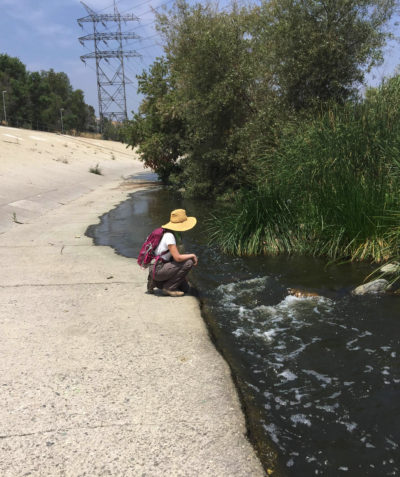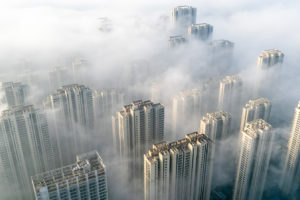In its natural state, before it was channeled and lined with concrete, the 51-mile-long Los Angeles River was often little more than a trickle for nine months of the year. During the rainy season, however, the small, braided stream would turn into a powerful, churning river. It behaved like a dropped firehose, wildly lashing the Los Angeles valley, scouring gravel and soil across a seven-mile-wide floodplain, and carving a new course with every deluge. When the waters receded, a mosaic of fertile marshes, ponds, and other wetlands remained.
“It was a big, flashy, dynamic river system,” says Sophie Parker, a biologist with the Nature Conservancy.
But such flash flooding wouldn’t do for a booming city, so in 1938, after a devastating torrent, a project to tame the Los Angeles River with a concrete straitjacket got underway. Since then, nearly the entire river has been funneled through a hard channel that allows no flooding. The city turned its back on the ditch, and public access to it was prohibited.
Nature Conservancy biologist Sophie Parker in the the Glendale Narrows section of the Los Angeles River. Jim Robbins/Yale e360
Over the past several decades, conservation organizations and neighborhood groups in the United States’ second-largest city have worked to recreate some semblance of nature along the waterway. Collaborating with city officials, these organizations have restored some small creeks and planted native trees and shrubs in new parks. But the work has been done piecemeal.
Now, however, the U.S. Army Corps of Engineers, partnering with the City of Los Angeles and conservation groups, is poised to launch the largest coordinated restoration effort of the Los Angeles River to date. The Corps recently completed a plan to remove three miles of river-killing concrete and enhance an 11-mile run through the Elysian Valley, a stretch called the Glendale Narrows. The Corps has asked Congress for $380 million to carry out the restoration effort, which will be combined with roughly $1 billion from the city.
Congressional funding is expected to be approved soon, helping launch a project that could take two decades or more to complete. But fundamental questions about bringing the L.A. River back to life remain: What, exactly, should this resurrected river be? And just what kind of natural bang will Angelenos and other Americans get for their billion-plus dollars?
This will not be the original L.A. River — trying to restore some semblance of naturalness to such a waterway faces major limitations. The river is no longer connected to groundwater and can’t be until toxic waste from a number of U.S. Defense Department facilities in the region — including the Santa Susana Field Station, a former rocket engine test center — are cleaned up. And the many places a living Los Angeles River would go, flooding and changing course, are now filled with roads, houses, and commercial buildings.
“We’re not going to be able to buy up or relocate people,” says Jill Sourial, the Nature Conservancy’s urban conservation director in Los Angeles.
With full restoration out of the picture, a different tangle of philosophical and practical questions remain. How far do you go to create a natural environment in a city? Is it enough just to make a concrete drainage ditch prettier? How much of the project should focus on removing concrete and creating some semblance of a functioning riverine ecosystem? And in a city with an estimated 47,000 homeless people (including many who live on islands in the L.A. River), gang problems, and a range of environmental threats — from wildfires to toxic waste sites — is the expense of $100 million per river-mile a wise use of taxpayer dollars?
Los Angeles is far from the only place addressing these kinds of issues. Many urban areas in the U.S. and around the world have realized that returning at least some nature to cities is vital, whether for green infrastructure that handles storm runoff, making cities cooler with trees and green space as the climate warms, or simply because more and more people live in urban areas and increasingly want more nature in their lives.
Seoul, the South Korean capital, answered the call of nature in 2005 by finishing the removal of a major highway from atop a three-mile stream called the Cheonggyecheon, which flows through the heart of the city. Europe’s Isar River — which flows from the Austrian Alps and through Munich, Germany, and has many similarities to the L. A. River — has had some five miles of similarly channeled river “naturalized”; the Isar now is a major attraction in Munich and is one of the leading models for Southern California’s restoration efforts.
In the U.S., the three rivers that flow through Milwaukee and into Lake Michigan — the Milwaukee, Menomonee, and Kinnickinnic — are being revitalized. And sliver by green sliver, pieces of New York City’s Bronx River — once one of the most blighted waterways in the country — are coming back.
But restoring a river that is dynamic and free-flowing remains a far-off, even impossible, dream for many urban areas. Rivers often flood, and while that may be hard on people and the things they build, it’s great for biodiversity. During a flood, mineralized nutrients and organic material are suspended in the river and groundwater, nourishing an array of biodiversity. And flooding continually creates a patchwork of diverse habitats, also promoting species diversity.
Questions about what the Los Angeles River could become may find answers in the Glendale Narrows, where some elements of naturalness will be reintroduced.
“It’s a new ecosystem type,” says Parker. “That’s why we don’t call it restoration. We call it habitat enhancement.” The Corps plan would recreate 719 acres of wetlands, remove three miles of concrete to create new riparian habitat, and re-establish a confluence with a stream called Verdugo Wash.
Slide bar from left to right to view the proposed restoration of wetlands at the junction of the L.A. River and the Verdugo Wash waterway. (Photos courtesy of The City of Los Angeles.)
On a recent walk along the “river” in the Glendale Narrows, it became clear how oddly unnatural it really is. Unlike the original L.A. River, today’s river now has substantial year-round flow, thanks to a water treatment plant that recycles sewage outflow from 800,000 homes in the San Fernando Valley and releases 23 million gallons a day into the channel. Torrents in the rainy season wash tainted urban runoff into the stream.
This 11-mile stretch is one of the only places that defied the Army Corps’ Depression-era efforts at control. The bottom of the river was so soft that the concrete would not stick. As a result, this section of river is a purling, cobble- and rock-studded waterway with swimming mallards, blue herons, and cormorants atop boulders drying their outstretched wings. Both banks, though, form a massive concrete trough.
Still, nature finds a way. It turns out that water sheeting over the concrete grows algae that are an important foraging habitat for shorebirds. Indeed, on the day I visited, a black-necked stilt was working these hard bottom shallows.
Within this 11-mile section is a 2.5-mile stretch where the Nature Conservancy, in collaboration with the Army Corps and the local community, will begin its work in the next couple of years. The Nature Conservancy has created a baseline of ecological conditions to measure the changes its work might bring, and the group is growing native plants needed for restoration in Griffiths Park.
Historical ecology — the study of old photos, maps, and diary accounts — will provide a sense of what the river once looked like, including the wildlife and plant species present. This will help guide restoration. “It gives you a sense of options for the future,” Parker says.
One major element of the Nature Conservancy project is the restoration of bird habitat. At one time, the Los Angeles River was characterized by perennial and seasonal wetlands, seeps, springs, swamps, riparian forests, and mud and alkali flats. “The reason L.A. was founded where it was is because it was an ecologically rich area,” Parker says. “There were grizzly bears, deer, mountain lions, and a lot of birds.”
Even a partially restored river will provide an escape from L.A.’s overwhelming urbanism.
More than 300 species of birds still visit what’s left of the river, flying between fragments of habitat. Two endangered species, the Southwestern willow flycatcher and the least Bell’s vireo, will benefit from the removal of a towering invasive plant from Asia known as giant reed (Arundo donax). It has taken over much of the riverbanks, and birds can’t nest in it. The arundo will be replaced with native plants, including several species of willow, sedge, and wild rye.
“This is one of the places where birds can make a comeback,” says Parker. “You need a bundle of different habitats.”
As habitat improves, the Nature Conservancy may consider reintroducing native amphibian or fish species that have disappeared. But there are some ecological functions that a revitalized L.A. River simply won’t be able to accommodate. The steelhead that once spawned here, for example, won’t be swimming up from the ocean at the mouth of the river at Long Beach anytime soon. Though they are endangered and badly in need of reproduction, the temperature of the water is too warm, and there are too many barriers.
Because of the river’s densely developed flood plain, it will only be allowed out of its straitjacket in a few places to flood again. I walked by one of those sites — a 42-acre Union Pacific Railroad property called Taylor Yard. The city is negotiating to buy the land, and one day the river could resume a semblance of its natural rhythm there, according to Erin Jones, an Army Corps biologist.
“They’ll bring the site down to the same grade as the river,” says Jones. “The river will be allowed to meander and create new habitat — marshland, riffles, and pools. It’s one of the larger sites where we can actually do restoration to more natural habitats and natural hydrology.” After serving as a rail yard for decades, the site will likely need hazardous waste cleanup first, Jones says.
Parker says she would love to see more of the river’s concrete removed and banks covered with native vegetation. This would provide significantly more ecosystem function, such as wildlife habitat, natural water cleaning, carbon sequestration, and nutrient recycling.
Other cities are doing more complete “living river” restoration. The city of Napa, California, for example, has a history of devastating floods. But in the Napa Valley — where some land sells for $300,000 an acre — some vineyards are pitching in as part of an effort to help return a 4.5-mile stretch of the floodplain to its natural condition. This includes restoring oxbows and marshes so that floodwaters can be absorbed naturally during spates, rather than flooding the city of Napa.
The Glendale Narrows won’t be the end of the L.A. River restoration. A group of government and non-profit groups are meeting to see how the lower 20 miles of river might be restored. This is a heavily urbanized stretch, running largely through low-income Latino neighborhoods, with just 3 percent consisting of parks, farms, or other open space. Remarkably, though, some small patches of wetlands there remain intact. Any work on this stretch is at least a decade off.
No matter how the Los Angeles River is restored, thinking about the river differently and embracing its presence — rather than dismissing it as a drainage ditch — is a teachable moment for Southern California. Even a partially restored river will provide an escape from Los Angeles’ overwhelming urbanism and will perform some important ecological functions.
“There’s something magical about coming to a place and seeing so many varieties of life,” says Parker. “The river provides that.”



